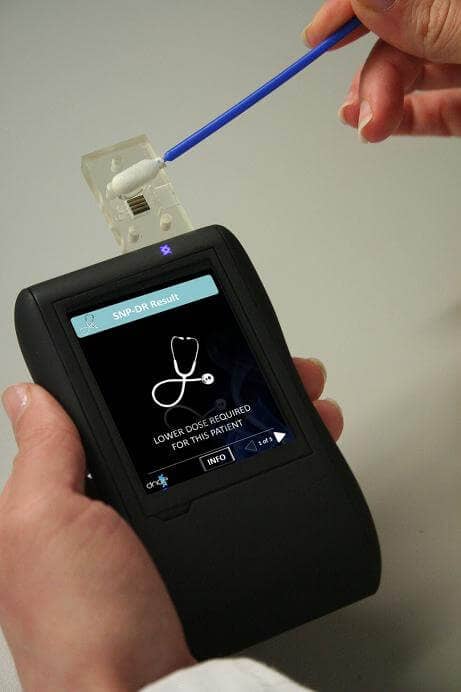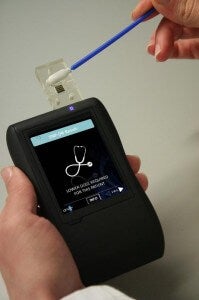DNA Electronics Has a Hand Held Genetic Testing Device – Interview with CEO!

Share

If your computer and your DNA had a baby, it would be the SNP Dr. from DNA Electronics. SNP Dr. is the world's first hand held semi-conductor device that will be able to read your DNA in about 15-30 minutes. I was able to chat with DNA Electronics CEO Prof. Chris Toumazou who is also the founder of Toumaz Technologies, the company that brought you Sensium. Toumazou let me in on how SNP Dr. will change medicine and genetic testing, and what we can look forward to in the future of semi-conductors and biology.
The current means of looking at your genetic code involves actual looking. Optic sensors help to pour through your DNA and discover variations. That technique is slow and difficult to scale down. Semiconductors, though, are getting faster and smaller every day. So a semiconductor device like SNP Dr. can be cheap and easily produced at a hand held size. Imagine a world where genetic testing could be done with just some spit, a cotton swab, and your iPhone.
A single nucleotide polymorphism or SNP (pronounced 'snip') is an interesting single-gene variation in your DNA. Geneticists have discovered hundreds, many of which can indicate proclivities to disease, physical traits, or negative reactions to medicines. Companies like 23andMe can test your DNA to see which SNPs you have. The SNP Dr, still in early prototyping, has a semi-conductor processor (a 'SNP chip') that reads your DNA by looking for a SNP. Which SNP? Depends on what you need to do. Are you a doctor trying to make sure you can proscribe someone a medicine without it killing them? Soldier checking for biological weapons? Farmer trying to figure out which seeds you should plant to avoid parasitic infestation? DNA Electronics could develop a SNP chip for any of the above.
Making semiconductors and biology play nice
Prof. Toumazou's background is in semiconductor design and engineering. He developed the ultra low power technology for IT applications that was adapted into medical sensing devices like Sensium. While working with a group trying to develop a cochlear implant, Toumazou started to realize that, "biology doesn't need the higher precision of digital processing...The [modern] world is digital, but human space is analog." Analog signals and processing mean lower power consumption and tinier devices.
But analog signals drift, which is problematic when you want to measure chemicals in body fluids like potassium, glucose, or urea (all one time projects of Toumazou). So what signal in your body doesn't drift? The one that's got all the important information anyway: your DNA.
With specialized molecules (polymerases) you can get reactions with DNA that release protons. That's an electrical signal you can track with semiconductor technology. Get the right kind of reactions going, and you can detect all the changes in DNA. Find when base pairs switch and you can start reading your genetic code just by measuring changes in electrical signals. It's like deciphering Morse Code when there is just four letters in the alphabet (GTCA). SNP Dr. represents one of the world's first looks at combining DNA logic with CMOS technology.
So can I buy one today?
Semiconductor technology is well explored and well understood, so it's no surprise that the semiconductor side of SNP Dr. is well underway. When the UK launched its Life Science Blueprint initiative to strengthen government support of biotech in Britain, guess what they got to see at the labs of Imperial College? Check out the prototype version of SNP Dr in the video below (0:28). Yep, that's Prime Minister Gordon Brown and Lord Drayson.
https://c.brightcove.com/services/viewer/federated_f8/1570028817
The current SNP Dr. prototype can actively demonstrate a number of SNPs on a single chip, but there's still a good deal of work to be done for a cotton swab of spit to interface with information technology. Toumazou says that they are already working with Pfizer, and other pharmaceutical companies on predicting drug responses in patients.
Prof. Toumazou is confident SNP Dr products can be developed and launched fairly quickly. Unregulated uses of DNA testing (such as having 23andMe looking at your genetic traits) could start adopting SNP Dr within the next 1-2yrs. Genomic studies, drug responses, and infection detection are all highly regulated, rightfully so, and will take a little longer to approve the new technology. According to Toumazou, These more rigorous uses of SNP Dr. will probably be seen in 2-5 years.
A SNP Dr. in every home
Be Part of the Future
Sign up to receive top stories about groundbreaking technologies and visionary thinkers from SingularityHub.



In terms of the overall business model, integrating genetics and semiconductor chips is still a very new field and a number of opportunities may emerge, from selling the handheld SNP Dr, to producing new and updated disposable SNP chips on a regular basis. But no matter where the most revenue may lie for DNA Electronics, you can bet they are going to make a big impact. For a couple of hundred dollars, almost any professional could buy a SNP Dr, a whole bag of SNP chips and get to testing. Doctors, farmers, soldiers, forensic scientists, cosmetic counter artists, personal trainers, or just the interested layman could suddenly test themselves and others for important genetic traits. Some of that activity is bound to be regulated, but it still leaves plenty of room for the SNP Dr. to find its place in the world.
It may be a very important place. With the ability to create new SNP chips at the rate of current silicon technologies (ask Intel how fast that is) we could see SNP Dr. become a rapid response tool in the fight against biological threats. Terrorist weapons? Sure, but think about infectious diseases like swine flu, blights on crops, or allergies to medicines. If scientists can find a SNP, DNA electronics can build a SNP chip for it. "Anything that has a defined sequence," says Toumazou, is fair game. After all, "it's not discovery, it's matching."
In fact, concentrating on matching doesn't just make SNP Dr. fast and reliable, it also makes it a logician. Toumazou says that SNP chips could be geared towards boolean logic. Does this organism have gene X AND gene Y? That enhances the applications we've already discussed and makes the technology a boon to synthetic biology. Anything a scientist can define a sequence for, DNA Electronics can help them detect in minutes. Genetic engineers will be able to search and sort their creations for traits nearly in real time. That's going to lead to some amazing developments.
An ounce of prevention
As I've said before, Toumazou is also the brains behind Sensium which will help health monitoring. Along with SNP Dr, we start to see a clear trend: the more you know, the healthier you can live. Toumazou is working to "change healthcare in the future, if you want to call it healthcare." Maybe the new paradigm is lifestyle management or lifecare. Why wait until you are ill to learn what will make you sick? Why wait until you are fat to learn how much exercise you need? Working with your doctors, human and hand held, will help answer these questions before they become problems.
Which is really the promise of merging semiconductors with genetics. Cutely named devices are great, but widespread improvements in healthcare are better. The possibility that anyone with the interest could affordably test themselves for genetic traits is amazing. That may alter the way we think of genetic information, our health, or even our identities. These are game-changing trends, and it's exciting to see them make their way to market. Hopefully DNA Electronics, and Prof. Toumazou will develop the biological sampling side of the SNP Dr. as quickly as planned so that we can start seeing the benefits of those trends in a few years.
After that, its back to breeding different technologies to produce crazy offspring devices. Particle colliders and Twitter...Tweetbomb?
[photos courtesy of DNA Electronics]
[video credit: Number10TV]
Related Articles

This Week’s Awesome Tech Stories From Around the Web (Through December 13)

New Immune Treatment May Suppress HIV—No Daily Pills Required

How Scientists Are Growing Computers From Human Brain Cells—and Why They Want to Keep Doing It
What we’re reading